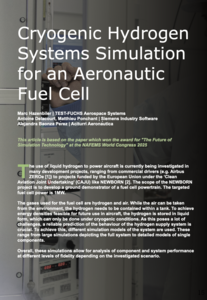
The use of liquid hydrogen to power aircraft is currently being investigated in many development projects, ranging from commercial drivers (e.g. Airbus ZEROe [1]) to projects funded by the European Union under the Clean Aviation Joint Undertaking (CAJU), such as NEWBORN [2]. The scope of the NEWBORN project is to develop a ground demonstrator of a fuel cell powertrain. The targeted fuel cell power is 1 MW.
The gases used for the fuel cell are hydrogen and air. While the air can be taken from the environment, the hydrogen needs to be contained within a tank. To achieve energy densities feasible for future use in aircraft, the hydrogen is stored in liquid form, which can only be done under cryogenic conditions. As this poses many challenges, a reliable prediction of the behaviour of the hydrogen supply system is crucial. To achieve this, different simulation models of the system are used. These range from large simulations depicting the full system to detailed models of single components.
Overall, these simulations allow for analysis of component and system performance at different levels of fidelity, depending on the investigated scenario.
This article appeared in the October 2025 Issue of BENCHMARK.



